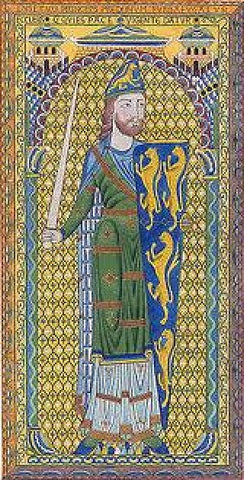The Lion is a lively image of a good soldier, who must be valiant of courage., strong of body, politicke in counsell, and a foe to feare.” -- Guillim, Display of Heraldry
The Armorial Roll of Caerlaverock from 1300 describes the Arms of the King of England as “ Three leopards of fine gold set on red; courant, fierce, haughty and cruel; to signify that like them the King is dreadful to his enemies, for his bite is slight to none who brave his anger, and yet towards such as seek his friendship or submit to his power his kindness is soon rekindled.” In heraldry a leopard represents a lion staring you in the face, the three lions have stood in the Royal Arms of England since the reign of Richard I. Their origin is uncertain but there is an interesting but doubtful theory as to their origin.
GEOFFREY, COUNT OF ANJOU
The seals of the first and second Williams and Henry I are free of Heraldry, but Henry seems to have used a single lion as a badge, and some historians think this may have been an allusion to the title “ Lion of Justice” by which Geoffrey of Monmouth, in the prophecies of Merlin, refers to the King. If this is the case, the first English lion may be regarded as commemorating the foundation of the administrative and legal system by the organization of the curia Regis for financial and judicial business, the establishment of itinerant justices to carry the King’s law throughout the land, and the strengthening of the popular courts to resist the encroachment of feudal franchises. It is significant that it was in the reign of Henry I that the first recorded lion was seen in England as part of the King’s menagerie at Woodstock. The main reason for believing that the lion was Henry I’s particular emblem is its prevalence in the Heraldry of the King’s descendents and those connected to his family by marriage. When Henry knighted his son-in-law, Geoffrey, Count of Anjou ( father of Henry II ), he gave him a shield charged with golden lions and this appears on an enameled figure of the Count formerly on his tomb. Here he also has a lion on his cap, the forerunner of the English Royal crest. Geoffrey’s grandson, William Longuespée, Earl of Salisbury, bore similar Arms, placing his golden lions upon a blue shield. There is evidence that Henry II himself bore two lions on his shield. Henry I’s descendents through his illegitimate children all bore one or more lions in their Arms.





